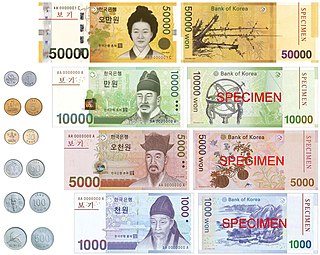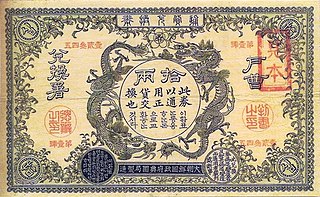
The yen is the official currency of Japan. It is the third-most traded currency in the foreign exchange market, after the United States dollar and the euro. It is also widely used as a third reserve currency after the US dollar and the euro.

The Korean won or Korean Empire won, was the official currency of the Korean Empire between 1900 and 1910. It was subdivided into 100 jeon.

The Korean People's won, more commonly known as the North Korean won and sometimes known as the Democratic People's Republic of Korea won, is the official currency of North Korea. It is subdivided into 100 chon. The currency is issued by the Central Bank of the Democratic People's Republic of Korea, based in the North Korean capital city of Pyongyang.

The South Korean won is the official currency of South Korea. A single won is divided into 100 jeon, the monetary subunit. The jeon is no longer used for everyday transactions, and it appears only in foreign exchange rates. The currency is issued by the Bank of Korea, based in the capital city of Seoul.
The Hong Kong dollar is the official currency of Hong Kong. It is subdivided into 100 cents. Historically, it was also subdivided into 1000 mils. The Hong Kong Monetary Authority is the monetary authority of Hong Kong and the Hong Kong dollar.
The New Taiwan dollar is the official currency of the Republic of China. Usually, the $ sign precedes the amount, but NT$ is used to distinguish from other currencies named dollar. The New Taiwan dollar has been the currency of the island of Taiwan since 1949, when it replaced the old Taiwan dollar, at a rate of 40,000 old dollars per one new dollar. The base unit of the New Taiwan dollar is called a yuan (圓), subdivided into ten chiao (角) or 100 fen (分), although in practice neither chiao nor fen are used.

The Taiwanese yen was the currency of Japanese Taiwan from 1895 to 1946. It was on a par with and circulated alongside the Japanese yen. The yen was subdivided into 100 sen (錢). It was replaced by the Old Taiwan dollar in 1946, which in turn was replaced by the New Taiwan dollar in 1949.

The yuan is the base unit of a number of former and present-day currencies throughout China.

The hwan (Korean: 환) was the currency of South Korea between February 15, 1953, and June 9, 1962. It succeeded the first South Korean won and preceded the second South Korean won.
The Old Taiwan dollar was in use from 1946 to 1949, beginning shortly after Taiwan's handover from Japan to the Republic of China. The currency was issued by the Bank of Taiwan. Hyperinflation prompted the introduction of the New Taiwan dollar in June 1949, shortly before the Nationalist evacuation from mainland China in December.

The yen was the currency of Korea, Empire of Japan between 1910 and 1945. It was equivalent to the Japanese yen and consisted of Japanese currency and banknotes issued specifically for Korea. The yen was subdivided into 100 sen. It replaced the Korean won at par and was replaced by the South Korean won and the North Korean won at par.

The yang (양/兩) was the currency of the Korean states Joseon and the Korean Empire between 1892 and 1902. It was subdivided into 10 jeon (전/錢) or 100 bun (분/分); and 5 yang = 1 hwan (환/圜).

The mun was introduced as the main currency of Korea in 1625 and stayed in use until 1892. Prior to the mun, cash coins with the inscriptions tongbo (通寶) and jungbo (重寶) and silver vases called ŭnbyŏng were used as currency in the Goryeo Dynasty (918–1392), as well as imported Chinese currency. The mun resembled and was derived from the Chinese wén. Coins denominated in mun were cast in copper-alloys such as brass or bronze and were round with square holes. From the 17th century until the end of the 19th century, coins denominated in mun bearing the inscription Sangpyeong Tongbo, introduced in 1633, were the most widely circulated currency. In 1888, coins were struck in small numbers denominated in mun and won. The mun was replaced in 1892 when the yang was introduced.
The won is the currency of both North and South Korea. "Won" is a cognate of the Chinese currency unit, the yuan, and the Japanese currency unit, the yen, meaning "round object". The won is subdivided into 100 jeon.
Japanese currency has a history covering the period from the 8th century CE to the present. After the traditional usage of rice as a currency medium, Japan adopted currency systems and designs from China before developing a separate system of its own.

Korean currency dates back as far as the Goryeo dynasty (918–1392) when the first coins were minted. The coins, cast in both bronze and iron, were called tongbo and jungbo. Additionally, silver vases called ŭnbyŏng were widely used and circulated as a currency among the aristocracy of Goryeo.
The 5 sen note (五銭紙幣) was a denomination of Japanese yen that was issued nonconsecutively from 1944 to 1948 in paper form. Five sen notes were worth one-twentieth of a yen, making them the lowest subsidiary yen banknote ever made. These notes were broken up into two types, which were issued before and after World War II. Those issued before the war filled a void left when 5 sen coin production became difficult. The second and final issue came after the war when the Japanese government tried unsuccessfully to curb inflation. Neither of these notes are currently legal tender as the "sen" was abolished in 1953 when the yen system was modified to exclude the old fractional currency. These banknotes are now easily collectable and affordable as they were issued in large amounts.
The 10 sen note (十銭紙幣) was a denomination of Japanese yen issued in four different series from 1872 to 1947 for use in commerce. Meiji Tsūhō notes are the first modern banknotes issued after Japanese officials studied western culture. There circulated alongside ten sen coins until their withdrawal in 1887. The other three series of ten sen notes issued are in some way tied to the impacts of World War I and World War II. Taishō fractional ten sen notes were issued as a response to a coin shortage that was caused by the first of these wars. They were eventually suspended in the early 1920s when things had settled down, and were later demonetized in 1948. The last two series of ten sen notes were issued by the Bank of Japan rather than the treasury. First series notes were issued as ten sen coins could no longer be produced, while the A series was released after the war in a futile attempt to curb inflation. These last two issues were demonetized at the end of 1953 when the Japanese government passed a law abolishing subsidiary notes in favor of the yen. Ten sen notes are now bought and sold as collectors items depending on condition.
The 20 sen note (二十銭紙幣) was a denomination of Japanese yen in three different government issued series from 1872 to 1919 for use in commerce. Meiji Tsūhō notes are the first modern banknotes issued after Japanese officials studied western culture. These notes were replaced due to counterfeting by a redesigned series called "Ōkura-kyō" for "sen" denominations. Both of these series were officially abolished in 1899 in favor of notes issued by the Bank of Japan. Government issued notes only returned during the Taishō era in the form of an emergency issue due to a coin shortage. These were only issued between 1917 and 1919 before they were finally abolished in 1948. Twenty sen notes are now bought and sold as collectors items depending on condition.
Japanese military currency (日本軍用手票) is the name given to money used by the Japanese armed forces for the purchase of supplies in occupied territories. It was mainly issued in denominations of yen, and subsidiary currency of sen with the exception of the first Sino-Japanese War series. This particular article covers pre-Shōwa era currency issued from 1894 to 1918 in three different periods. During this time Japan was militarily involved in the First Sino-Japanese War, Russo-Japanese War, and events during World War I such as the Siberian intervention. The military currency issued during these events circulated in Japanese Korea, the Republic of China (Manchuria), and the Russian State. All of the notes issued share a similar design which resembles government issued civilian currency which circulated in Japan from 1872 to 1899. Japanese military currency was exchangeable at the given time for both silver and gold bullion. Most of these events were not long term which impacted the amount of surviving currency in different ways. It was also routine after each event for officials to exchange the military currency issued for bullion or other forms of payment such as banknotes. Unredeemed notes were thus either held by the public as commemorates or eventually lost in the decades that followed. Those that remain today are collected and traded depending on the condition and surviving rate of the series.














